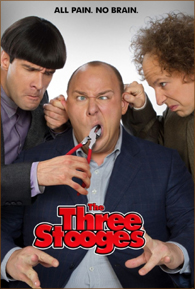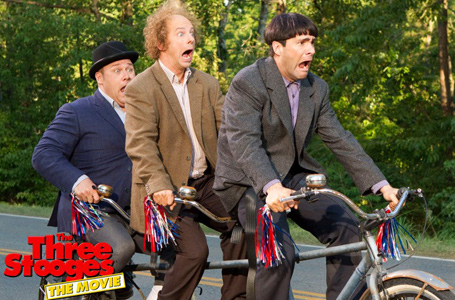
In The Three Stooges, a trio of minor league television comedians fill the roles inhabited by the long-dead Moe, Larry, Curly, and Shemp as they recreate the looks, mannerisms, and classic routines of the trio. Perhaps as an acknowledgement that the best work of the Three Stooges were their shorts and never their feature film projects, The Three Stooges tells its story as three episodes or chapters stringed together: an opener where the trio is introduced as very over-aged charges of an orphanage run by Catholic nuns and a two-part caper where the trio must enter our world to raise enough money to save the orphanage from closure. The caper section even plays like one of the stories the original Stooges might have written — a tai-tai decides to kill her rich dim-witted husband for his money and ends up employing the Stooges to do the dirty work.
If you loved the original Three Stooges shorts that once aired on television, you'd probably love this film just for the nostalgia value. That said, I was more impressed by the extent to which the three comedians managed to pin down the look, mannerisms, and voices of the original trio. As a comedy though, the puns were very painful to sit through, the poke in the eye routine was probably more suited to a short rather than serving as the punchline to every joke in a 90-minute feature, and truth be told, the Three Stooges act hasn't aged well at all.
As far as I can see, the trio (Moe, Larry, and Curly or Moe, Larry, and Shemp depending on your allegiances) and their brand of comedy are the live action equivalent to the slapstick violence exemplified in the original run of the Looney Tunes cartoons. Instead of getting blown to smithereens and then standing up and walking away none for the worse, the punchline to every Three Stooges joke would be a slap on the face, a poke in the eye, a box on the nose, and a well-aimed hammer to the head.
Chaplin created an iconic character that appeals to our instinctive desire to root for the underdog. Laurel and Hardy not only had a great onscreen chemistry that made their odd couple routine engaging but also were brilliant writers who knew just how to milk a joke to absurd lengths and twists and plot elaborate onscreen fights. The Marx Brothers were vaudeville through and through but they could throw an assortment of gags high and low into any plot, string them together into a feverish, often surreal climax. Compared to these giants of Hollywood's Silver Age of comedy, The Three Stooges are second bananas — less talented but memorable because of the childlike simplicity of their comedy routine.
With a comedy that is almost pedestrian in its simplicity, it is appropriate then that the Farrelly Brothers' tribute to The Three Stooges is a modest effort with modest achievements despite the ambition of the project.












 列印版本
列印版本

















